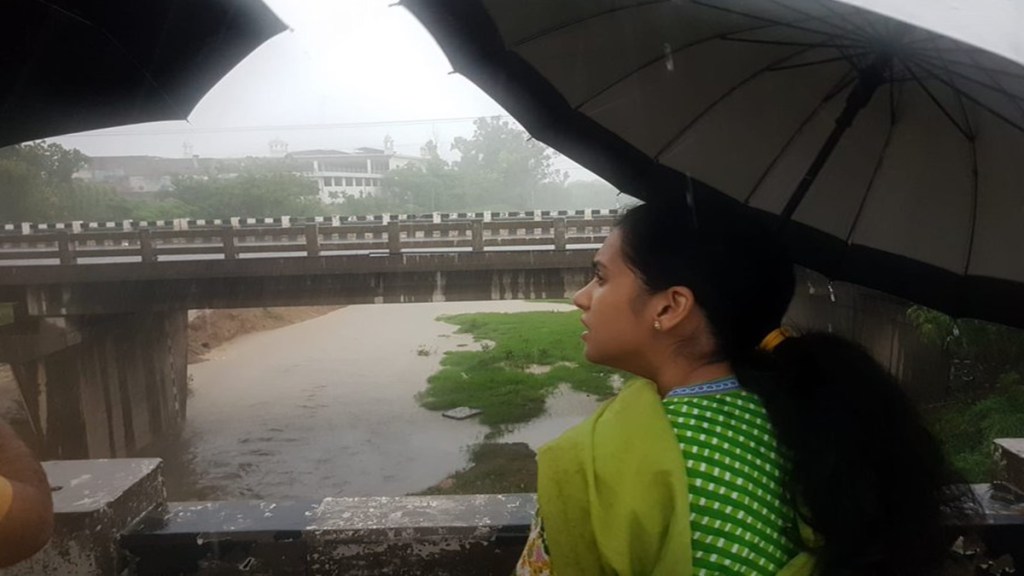Amid the ongoing rescue efforts in Punjab following devastating floods, Deputy Commissioner Sakshi Sawhney of Patiala has adopted a hands-on approach to tackle the situation.
A few days ago, as Patiala faced the overwhelming challenge of rising waters from various sources inundating both urban and rural areas, Deputy Commissioner Sakshi Sawhney’s message started circulating widely.
Shared on popular social media platforms like Facebook and WhatsApp, the message served as a beacon of hope amidst the gloom faced by the district’s residents. It provided assurance, relief, and, most importantly, a commitment to safely evacuate everyone from the perilous zones.
Also Read: Delhi floods: Why is the national capital battling an unprecedented deluge?
Sakshi Sawhney, a young IAS officer serving in her first posting as the district’s deputy commissioner, has been earning praise and admiration from the people of Patiala as they navigate their way to relief camps amid the crisis.
Local residents attest to Sawhney’s constant presence among them during times of crisis. She communicates directly with the people, dispelling rumors and misinformation, while leaving her three-year-old daughter behind at home. Sawhney tirelessly remains in the field until late at night, even wading through deep waters, to oversee evacuation operations.
Sawhney, a 2014-batch IAS officer and the daughter of retired IRS officer Sunil Sawhney, previously served as the ADC of Mohali and Bathinda.
Also Read: Delhi floods spare none! Yamuna water now dangerously close to CM Kejriwal’s residence
As the water levels began to rise and encroach upon residential areas in Patiala on Monday, Sawhney, according to officials from the Patiala district administration, embarked on field visits. She worked diligently throughout the day, identifying sensitive areas that required immediate evacuation.
“By Sunday night, the Army had been called in, and nearly 3000 students from Chitkara University, Rajpura, were urgently evacuated. Sawhney was present throughout the operation, which continued until Monday morning. Since the crisis escalated on Monday, she has been in the field until 2 or 3 am daily, taking a brief rest at home before restarting her day at 6 am. When the official landline number became overwhelmed with calls, she began attending to calls on her personal mobile number,” said an official.
In an interview with The Indian Express, Sawhney said her primary focus was on minimising casualties. “I joined WhatsApp groups of Residential Welfare Associations (RWAs) to directly address queries and dispel rumors. During such challenging times, people need reassurance and kindness; they need to know that someone is there for them. I spend most of my time in the field because it allows me to interact directly with the people and assure them that we will rescue them,” she explained.
For instance, when the flood control room in Patiala received numerous messages regarding power failures, she took to the administration’s official Facebook page to provide updates. One of her posts read,
“This is DC Patiala Sakshi Sawhney IAS. This advice is for colonies where rescue operations are taking place. 1. The technical team advises against turning on electricity while floodwater remains. We must wait for the water to recede. 2. Water supply can only be restored once we can resume electricity. 3. We will provide whatever you need while awaiting evacuation. 4. If an evacuation team is present, it is recommended to evacuate as it may take some time for the water level to subside and electricity to be restored.”
Sawhney acknowledged that convincing people to leave their homes has been the most challenging aspect of the evacuation process. In one of her Facebook posts on the official page, she addressed the residents of Urban Estate 1, requesting their cooperation with evacuation efforts: “It is not advisable to stay if you are being specifically asked to evacuate. The water level is high.” Sawhney also provided live updates from various locations, notifying people about colonies where water levels were expected to rise and those undergoing evacuation.
So far, three casualties have been reported in Patiala district: a government pharmacist who had an accident while en route to duty, a student from Chitkara University, and another resident from Gopal Nagar. “Patiala is threatened by rising waters mainly from Badi Nadi, Ghaggar, and Tangri rivulet. We have already evacuated nearly 6000 people with the assistance of the Army and NDRF, and relief operations are ongoing. The worst-hit divisions are Patran, Rajpura, Patiala city, Samana, and Ghanaur. Approximately 70 villages in the district remain highly sensitive,” Sawhney disclosed.
During her field visits, Sawhney designates a person to manage her Facebook and Twitter accounts to ensure that no distress messages are overlooked. “Sometimes, we have to prioritise the evacuation of individuals with health conditions or in need of medical assistance. This can lead others in the vicinity to assume they won’t be evacuated. To maintain their patience, we continue posting alerts that everyone will be rescued,” she added.

